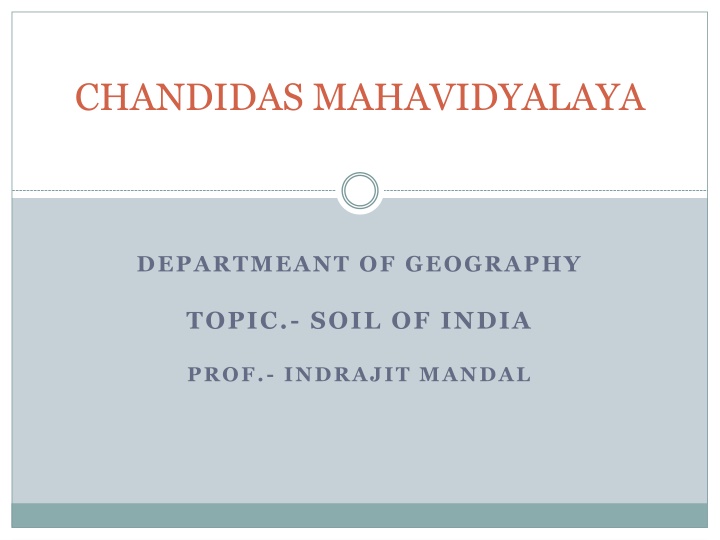CHANDIDAS MAHAVIDYALAYA
This study focuses on the soil of India, led by Professor Indrajit Mandal at Chandidas Mahavidyalaya Department of Geography. The research delves deeply into the composition, characteristics, and significance of Indian soils, offering valuable insights for geographers, environmentalists, and policymakers alike. By exploring the diverse soil types found across the country, this analysis aims to contribute to a better understanding of India's ecosystem and land use patterns.
Download Presentation

Please find below an Image/Link to download the presentation.
The content on the website is provided AS IS for your information and personal use only. It may not be sold, licensed, or shared on other websites without obtaining consent from the author.If you encounter any issues during the download, it is possible that the publisher has removed the file from their server.
You are allowed to download the files provided on this website for personal or commercial use, subject to the condition that they are used lawfully. All files are the property of their respective owners.
The content on the website is provided AS IS for your information and personal use only. It may not be sold, licensed, or shared on other websites without obtaining consent from the author.
E N D
Presentation Transcript
CHANDIDAS MAHAVIDYALAYA DEPARTMEANT OF GEOGRAPHY TOPIC.- SOIL OF INDIA PROF.- INDRAJIT MANDAL
TOPIC :- SOIL OF INDIA Definition of Soil Soil can be simply defined as a mixture of small rock particles/debris and organic materials/ humus which develop on the earth surface and support growth of plants.
Soil Classification Urvara vs Usara In India, soil had been classified from the ancient period itself even though it was not as detail as the modern classifications. In the ancient period, the classification was based on only two things; whether the soil is fertile or sterile. Thus the classification were: Urvara [fertile] Usara [sterile
Soil Classification Agencies involved In the modern period, when men started to know about the various characteristics of soil they began to classify soil on the basis of texture, colour, moisture etc. When the Soil survey of India was established in 1956, they studied soils of India and their characteristics. The National Bureau of Soil Survey and the Land Use Planning, an institute under the control of Indian Council of Agriculture Research did a lot of studies on Indian soil.
Major classification of Indian soils Alluvial soil [43%] Red soil [18.5%] Black / regur soil [15%] Arid / desert soil Laterite soil Saline soil Peaty / marshy soil Forest soil Sub-mountain soil Snowfields
1. Alluvial soil: Mostly available soil in India (about 43%) which covers an area of 143 sq.km. Widespread in northern plains and river valleys. In peninsular-India, they are mostly found in deltas and estuaries. Humus, lime and organic matters are present. Highly fertile. Indus-Ganga-Brahmaputhra plain, Narmada-Tapi plain etc. are examples. They are depositional soil transported and deposited by rivers, streams etc. Sand content decreases from west to east of the country. New alluvium is termed as Khadar and old alluvium is termed as Bhangar.
Colour: Light Grey to Ash Grey. Texture: Sandy to silty loam or clay. Rich in: potash Poor in: phosphorous. Wheat, rice, maize, sugarcane, pulses, oilseed etc are cultivated mainly.
2. Red soil: Seen mainly in low rainfall area. Red Soil in India are poor in phosphorus, nitrogen and lime contents. The red soils covers a large portion of land in India. It is found in Indian states such as Tamil Nadu, southern Karnataka, north-eastern Andhra Pradesh and some parts of Madhya Pradesh, Chhattisgarh and Odisha. Wheat, cotton, pulses, tobacco, oilseeds, potato etc are cultivated.
3. Black soil / regur soil: Regur means cotton best soil for cotton cultivation. Most of the Deccan is occupied by Black soil. High water retaining capacity. Rich in: Iron, lime, calcium, potassium, aluminum and magnesium. Colour: Deep black to light black. It is mostly found in areas such as Gujarat, Madhya Pradesh andMaharashtra. It is also found in states like Tamil Nadu, Andhra Pradesh and Karnataka. Black soil is extremely fine and clayey and has the capacity to hold a lot of moisture.
4. Laterite soil: Rich in: Iron and Aluminum Deficient in: Nitrogen, Potash, Potassium, Lime, Humus Colour: Red colour due to iron oxide. Rice, Ragi, Sugarcane and Cashew nuts are cultivated mainly. These soils have mainly developed in the higher areas of the Peninsular plateau. The laterite soils are commonly found in Karnataka, Kerala, Tamilnadu, Madhya Pradesh and the hilly areas of Orissa and Assam. Soil Colour: Reddish brown in colour due to the presence of iron oxide.
5. Saline soil: Saline soil are found in the coastal area of the any country . Crops tolerant include cotton, alfalfa, cereals, grain sorghum, sugar beets, Bermuda grass, tall wheat grass and Harding grass. Salinity higher than desirable for greenhouse soils. Strongly saline.
6. Desert / arid soil: In general, Desert soil is found in arid and semi arid areas with low rainfall.Such places are Rajasthan ,some parts of Gujarat,Haryana and Punjab. Deposited mainly by wind activities. High salt content. Lack of moisture and Humus. Kankar or Impure Calcium carbonate content is high which restricts the infiltration of water. Nitrogen is insufficient and Phosphate is normal. Texture: Sandy Colour: Red to Brown.
7. Peaty / marshy soil: Areas of heavy rainfall and high humidity. Growth of vegetation is very less. A large quantity of dead organic matter/humus which makes the soil alkaline. Heavy soil with black colour. This type soil are found in Kerala.
8. Forest soil: Regions of high rainfall. Humus content is less and thus the soil is acidic. It is the most important type of soil found in the country as it covers about 40% of the total land. It is found in the northern plains beginning from Punjab to West Bengal and Assam. It is also found in deltas of different rivers such as Krishna, Godavari, Kaveri and Mahanadi in peninsular India.
9. Mountain soil: In the mountain regions of the country. Immature soil with low humus and acidic. Mountain soil are mainly found on the hill slopes.These soils are formed due to mechanical withering caused by snow,rain,temperature variation,etc. These mountain soils are found in hilly regions of Jammu and Kashmir,Sikkim, Assamand Arunachal pradesh.These soils occupy about 8% of the total land area of India.
10. Snowfields This type of soil are found in the polar and mountain area. Like Himalaya Region.
THANK YOU











